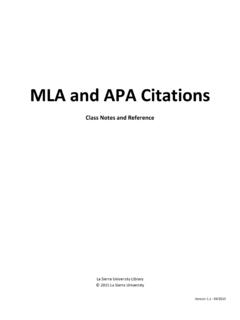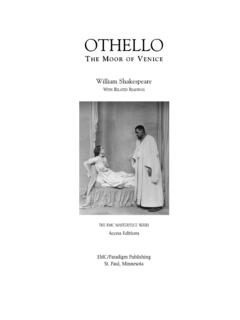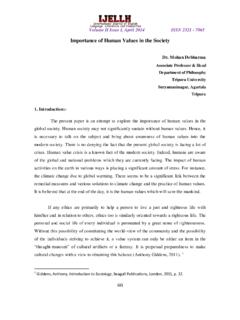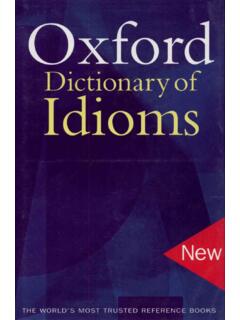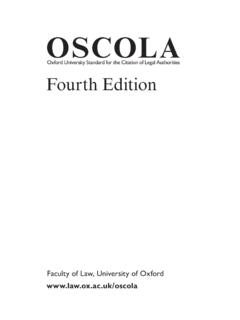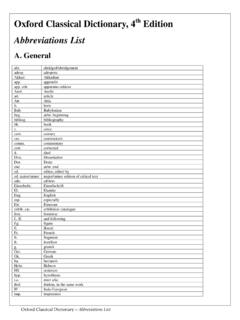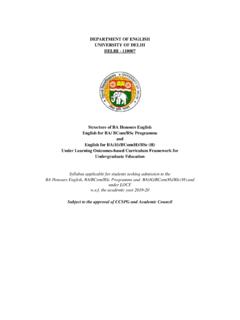Transcription of The Meaning and Message of the Beatitudes in the Sermon …
1 The Meaning and Message of the Beatitudes in the Sermon On the Mount (Matthew 5-7) Ranko Stefanovic Andrews University The Sermon on the Mount recorded in Matthew 5-7 is probably one of the best known of Jesus teachings recorded in the Gospels. This is the first of the five discourses in Matthew that Jesus delivered on an unnamed mount that has traditionally been located on the northwest shore of the Sea of Galilee near Capernaum, which is today marked by the Church of the Beatitudes . New Testament scholarship has treated the Sermon on the Mount as a collection of short sayings spoken by the historical Jesus on different occasions, which Matthew, in this view, redactionally put into one A similar version of the Sermon is found in Luke 6:20-49, known as the Sermon on the Plain, which has been commonly regarded as a Lucan variant of the same discourse.
2 2 The position taken in this paper is, first of all, that the Matthean and Lucan versions are two different sermons with similar content delivered by Jesus on two different occasions. 3 Secondly, it seems almost certain that the two discourses are summaries of much longer ones, each with a different emphasis, spiritual and physical respectively. Whatever position one takes, it appears that the Sermon on the Mount in Matthew is not just a collection of randomly selected pieces; the discourse displays one coherent literary theme. The Sermon is introduced with the Beatitudes , which are concluded with a couplet of short metaphoric parables on salt and light.
3 This is further followed by a collection of practical messages in which Jesus contrasts the true disciples with the Scribes and the Pharisees (5:20-7:23). The Sermon concludes with a couplet parable of the two builders. This paper suggests the following structure of Matthew s Sermon on the Mount: 1 Robert A. Guelich, The Sermon on the Mount: A Foundation for Understanding (Waco, TX: Word, 1982), 35-36; Donald A. Hagner, Matthew 1-13, Word Biblical Commentary 33A (Dallas, TX: Word Books, 1993), 69, 89-91; Hans Dieter Betz, The Sermon on the Mount, Hermenia A Critical and historical Commentary on the Bible (Minneapolis, MN: Fortress Press, 1995), 44-45.
4 2 While the two discourses show some striking resemblances, they, however, also show some obvious differences. Common to them is that they each begin with a list of statements known as the Beatitudes and conclude with a short metaphoric parable of the two builders. The main difference between the two versions lies in what is found in between the Beatitudes and the parable of the two builders. 3 See Leon Morris, The Gospel According to Matthew, Pillar New Testament Commentary (Grand Rapids, MI: Eerdmans, 1992), 93; Michael J. Wilkins, Matthew, The NIV Application Commentary (Grand Rapids, MI: Zondervan, 2004), 193-194. While the discourse in Matthew was spoken on a mount (5:1), in Luke it was spoken on an unidentified plain (Luke 6:17).
5 In Matthew, the Beatitudes are in the third person plural, in Luke, they are in the second person plural. The emphasis of the Beatitudes in Matthew is on spiritual qualities, while in Luke it is on physical and material things with the addition of the woes (Luke 6:24:26). 2 A. Beatitudes (5:3-12 B. Couplet Parables of Salt and Light (5:13-16) 1. Righteousness that Exceeds (5:17-6:18) Antitheses (5:21-48) Fasting (6:1-4) Praying (6:5-15) Charity (6:16-18) 2. Worrying about Tomorrow (6:19-34) 3. Judging Others (7:1-6) 4. Praying (7:7-11) 5. The Narrow and Wide Gates (7:12-14) 6. Known by their Fruits (7:15-23) C.)
6 Couplet Parable of the Two Builders (7:24-27) In this structure, the Beatitudes (5:3-12) function as the springboard passage upon which the couplet of metaphoric parables on salt and light are built. The verb mwrai/nw, to be foolish (in 5:13) and its cognate adjective mwro/ , foolish (in 7:26) link the couplet of parables on salt and light with the couplet parable of the two builders. This suggests that the parables on the salt and light and the two builders function as an inclusio defining the theological Meaning of the rest of the Sermon . Matthew 5:1-2 shows that Jesus spoke the Sermon on the Mount primarily with his disciples in mind as they were about to be sent to proclaim the Message of the kingdom (Matt.)
7 10). The purpose of this paper is to explore the Meaning of the Beatitudes in connection with the couplet of metaphoric parables of salt and light in Matthew 5:13-16 in light of the structure of the Sermon on the Mount and the Message they originally communicated to the disciples. The Beatitudes (5:3-12) The Sermon on the Mount begins with an introductory section consisting of eight (or nine) pronouncements that are commonly known as the Beatitudes , each beginning with the Greek adjectival plural maka rioi. The word beatitude comes from the Latin beatitudo which corresponds to the Greek makarismo/ from which the Anglicized word macarism ( happiness ) comes.
8 The term denotes a literary form that was commonly used in the ancient world commending or praising a person for favor received in In the classical Greek, the adjective maka rio is a longer form of the older word ma/kar ( blessed, happy ).5 The word ma/kar was first used by poets to describe the transcendent happiness enjoyed by gods who were referred to as the blessed ones (oi maka re ).6 The word 4 Beatitudes probably originated in Egypt and were adopted by Greeks (see Jacques Dupont, tude sur les uangiles synoptiques, BETL 70 [Leuven: Peeters and Leuven University, 1985], 2:793-831).
9 5 Henry G. Liddell and Robert Scott, A Greek-English Lexicon, 9th ed. (Oxford: Clarendon Press, 1968), 1073. 6 See Friedrich Hauck, maka rio , et al., Theological Dictionary of the New Testament, ed. 3 was also used for deceased persons who shared in the supra-earthly existence of gods in the isle of the The Meaning of the word maka rio and its cognate verb makari zw originally corresponded to the older form ma/kar. However, the word gradually came to be applied to living persons; at first, it was used for the freedom of the wealthy from the worries and cares of life because of their wealth. From Aristotle on, it was a common word used to describe persons who were secure from the hardships of life.
10 It usually appeared in a formal construction: happy is he who .. (maka rio o ..) or happy are those who .. (maka rioi oi ..). People were regarded fortunate and happy because they possessed things that were supposed to produce happiness including wealth,8 fame,9 power,10 a life of pleasure,11 freedom from suffering,12 family,13 wisdom and knowledge,14 etc. The word could also have a religious Meaning of being blessed. 15 In the LXX, maka rio generally translates the Hebrew word y rVvAa, which is used 45 times in the Hebrew The word occurs mainly in Psalms and the Wisdom Literature acclaiming persons for their piety and faithfulness to God.


